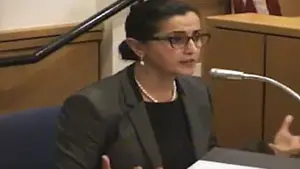

The Expert: Dr. Annie Yessaian, a professor of obstetrics and gynecology at the University of Southern California’s Keck School of Medicine.

Dr. Annie Yessaian, a gynecologic oncologist with the University of Southern California, gives critical testimony for the plaintiff in the case of Eva Echeverria v. Johnson & Johnson. The case involved the long-term use of talc manufactured by J&J and the subsequent development of serous adenocarcinoma of the ovary in Eva Echeverria. Yessaian connects these two events, convincing the jury that the long-term use of talc more probably than not caused the development of the patient’s cancer.
The expert’s testimony includes her description of studies that imply a causal relationship between talc and ovarian cancer according to their odds ratio. Odds ratios are used to compare the relative odds of the occurrence of an outcome such as a disease, given exposure to a particular variable, such as a chemical. The odds ratio asks the likelihood of that outcome in the presence of the variable, as opposed to when the variable is not present. In this case, a ratio of 2 or more indicates there is a greater than 50% chance that talc was associated with the development of the carcinoma.
One study Yessaian describes, from Harvard in 1982, contained 200 patients with ovarian cancer as well as 200 control patients. The patients with ovarian cancer had utilized talc by direct application to the genital area as well as on the sanitary napkins that they used. The doctor stresses that “confounding factors” that might interfere with this interpretation were eliminated in the study. When the women in this study used the talc, she reported that the relative risk was 3.28 that they would develop ovarian carcinoma, meaning that those using talc were 3.28 times as likely to develop ovarian carcinoma as those who did not use talc. This was a statistically significant result.
In 1992, a study from Johns Hopkins, looking at women just applying the talc to sanitary napkins, found a risk of 4.8 for the development of ovarian carcinoma. Another Harvard study, in 1999 and containing over 1,000 patients with ovarian cancer, looked at powdering on the genital area and found a risk of 2.15. This particular study also looked specifically at invasive serous adenocarcinoma of the ovary and calculated a risk of 1.70. All of these findings were statistically significant.
The final study she presents was performed in 2009, and it was from the University of Southern California, where Yessaian practices. This study looked at the duration and frequency of the use of talc by women with ovarian carcinoma. It confirmed a relative risk of 2.08 for all ovarian cancers and 1.70 for the serous adenocarcinoma that the plaintiff had. These figures were also statistically significant, again affirming a definite relationship between the use of talc and the development of ovarian carcinoma rather than being just a matter of chance.
When the doctor was asked about how she would weigh those risks in determining whether talc actually causes ovarian carcinoma, she says she took into account more than 30 or 40 studies and 75 publications before forming an opinion. Furthermore, Yessaian looked at the dose-response as an element to consider, since the longer the talc was used, the higher the cumulative dose was. She states that there was a correlation between the amount of time that talc was used and the risk of developing ovarian cancer.
Finally, applying this information to Echeverria’s specific case, Yessaian points to the fact that talc was found in her ovarian cancer tissue. She explains that talc migrates through the vagina onto the ovary, and causes inflammation there. Inflammation then can cause “cancerous transformation from very well-established pathways.” Therefore, she concludes “that talc was, more probable than not, the causing agent in Ms. Echeverria’s development of high-grade, serous ovarian cancer.” Furthermore, she opines that without the use of talc, this patient would not have developed her cancer.
This damning expert testimony, given with the conviction and authority of one who is well respected in her field, led the jurors to award the plaintiff $417 million. Although the verdict was subsequently set aside by the trial judge, Yessaian’s testimony was crucial to building the plaintiff’s case for the jury.
Gary Gansar, MD, is residency-trained in general surgery. He served as Chief of Surgery and Staff at Elmwood Medical Center and on the Medical Executive Committee at Touro Infirmary and Mercy Hospital in New Orleans, LA. Dr. Gansar was Board Certified in general surgery while in active practice. He joined AMFS in 2015 as a Physician Medical Director.
The medical expert witness partner for attorneys serious about building a winning case
AMFS is your trusted source for highly-qualified medical expert witnesses. After pioneering the field nearly three decades ago, we’re continuing to redefine medical expert witness services by providing value far beyond a referral alone.
Our Physician Medical Directors know what it takes to build a strong case. Our medical expert witnesses leave no doubt. And our case managers streamline billing and logistics every step of the way, letting you focus on what you do best: constructing your winning case. Explore why AMFS clients expect more from their medical expert witnesses—and get it.
